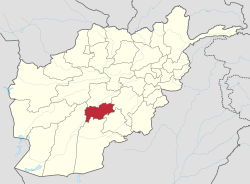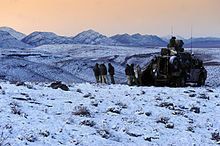Uruzgan Province
Uruzgan
ارزګان | |
|---|---|
 Aerial photograph of fields in Uruzgan Province | |
 Map of Afghanistan with Uruzgan highlighted | |
| Coordinates (Capital): 32°48′N 66°00′E / 32.8°N 66.0°E | |
| Country | |
| Capital | Tarinkot |
| Government | |
| • Governor | Haji Dawat[1] |
| • Police Chief | Mullah Abdullah Bashir[2] |
| Area | |
• Total | 12,640 km2 (4,880 sq mi) |
| Population (2020)[3] | |
• Total | 436,079 |
| Time zone | UTC+4:30 (Afghanistan Time) |
| Postal code | 41xx |
| ISO 3166 code | AF-URU |
| Main languages | Pashto and Dari |
Uruzgan (Pashto: ارزګان; Dari: ارزگان), also spelled as Urozgan or Oruzgan, is one of the thirty-four provinces of Afghanistan. Uruzgan is located in the center of the country. The population is 436,079,[3] and the province is mostly a tribal society. Tarinkot serves as the capital of the province. Uruzgan borders the provinces of Kandahar, Daykundi, Ghazni, Zabul, and Helmand.
Geography
[edit]Uruzgan province is located in southern Afghanistan, bordering Zabul and Kandahar to the south, Helmand to the southwest, Daykundi to the north, and Ghazni to the east. Uruzgan covers an area of 12,640 square kilometres (1,264,000 ha). Much of the province is mountainous or semi-mountainous terrain, while the rest of the area is made up of flat land.[4]
History
[edit]The Arabs were first to arrive in Uruzgan in the 7th century when they brought Islam to the region followed by the Saffarids who conquered the place in the 9th century. The region was part of ancient Arachosia, and was ruled by the Medes before it fell to the Achaemenids. In 330 BC, Alexander the Great occupied the area but left it to the Seleucids to rule. It was later attained and ruled by the Mauryas under Ashoka.[citation needed] By the 7th century, when the Arabs first arrived, it was under the control of the Zunbils before being conquered in the name of Islam by the Saffarids in the 9th century. It fell to the Ghaznavids followed by the Ghurids before the Mongol invasion in the 13th century.[citation needed] The area was ruled by Arghun Khan of Ilkhanate, later by the Timurids, Mughals and Safavids.[citation needed]
During the 1980's Soviet war in Afghanistan, Uruzgan witnessed fighting between pro-Soviet forces and the Mujahideen. One of the most prominent local Mujahideen leaders was Jan Mohammad Khan. In late 1994, Uruzgan was captured by the Taliban.[citation needed] They were toppled by US-led forces in late 2001. Hamid Karzai and his followers arrived in Uruzgan between October and November 2001 to take over control of the area.[citation needed]
Recent history
[edit]
In June 2002, a wedding party in Uruzgan was bombed by the U.S. Air Force, which resulted in the death of 30 civilians.[5]
In 2004, the new Daykundi Province was carved out of an area of northern Uruzgan.
In August 2006, the NATO-led International Security Assistance Force (ISAF) assumed authority for Uruzgan from the US-led coalition, as the Netherlands took command of the Provincial Reconstruction Team (PRT) from the US as Task Force Uruzgan. There is also an Australian element under the Dutch command.

Because of security concerns and the Taliban insurgency, only one international aid agency (GIZ) has a permanent presence in Uruzgan. NATO's ISAF operates a PRT in Tarinkot. The 1,400 Dutch and 1,090 Australian troops in the area secured only the largest population centers in Uruzgan (Deh Rawood, Chora, and Tarinkot towns) under the Dutch "inkspot policy". However, the force's area of responsibility included the entire province. Gizab district, which was then the most dangerous of Uruzgan's district, had no ISAF presence before. In August 2010, the 1,950 Dutch forces withdrew their forces from Uruzgan province, after a political disagreement in the Dutch parliament, leaving the PRT to the US and Australia to continue the mission.

Uruzgan's opium poppy crop reached record levels in 2006 and 2007, according to the United Nations Office on Drugs and Crime (UNODC), as no significant eradication efforts were carried out by the Afghan administration or Dutch forces.
Between 15 and 19 June 2007, Dutch, American, Australian and Afghan soldiers defended the town of Chora against an assault by Taliban combatants. Reports in the Dutch, Australian[6] and US press[7][8][9] indicated that the battle was one of the largest Taliban offensives of the year. The fighting resulted in the deaths of a Dutch soldier, 1 Australian soldier, 1 American soldier, 16 Afghan policemen, an unknown number of civilians and a large number of Taliban.
In September 2008, Rozi Khan, the leader of Uruzgan's Pashtun Barakzai tribe, and a longtime rival of Popalzai leader Jan Mohammed Khan, was killed in a firefight in Chora District.
Gizab District was temporarily cleared of the Taliban by ISAF forces in late April 2010 and this was attributed to the uprising of the townspeople who helped the ISAF forces.[10][11]
In February 2010, near Khod, over ten civilians in a three-vehicle convoy were killed by a combined force of a Lockheed AC-130, Bell OH-58 Kiowa helicopters and General Atomics MQ-1 Predator drones, who misidentified them as Taliban. The air forces were attempting to protect ground troops fighting several km away.[12][13]
Transportation
[edit]As of May 2014, the province was served by Tarinkot Airport which had regularly scheduled direct passenger service to Kabul.
Healthcare
[edit]The percentage of households with clean drinking water increased from 8% in 2005 to 27% in 2011.[14] The percentage of births attended to by a skilled birth attendant increased from 6% in 2005 to 14% in 2011.[14]
Education
[edit]The overall literacy rate (6+ years of age) increased from 5% in 2005 to 17% in 2011.[14] The overall net enrollment rate (6–13 years of age) increased from 1% in 2005 to 49% in 2011.[14]
Demographics
[edit]
As of 2020, the total population of the province is about 436,079.[3] The province has an estimated 45,000 households, each with about six members on average. A large portion of Uruzgan's population is ethnic Pashtun and ethnic Hazara.[15] There is also a small population of the nomadic Kochis, whose numbers vary with the seasons.[15]
Population figures are from the Ministry of Rural Rehabilitation and Development, the Central Statistics Office Afghanistan, and the Liaison Office study 2009.[16]
Districts
[edit]| District | Capital. | Population[17] | Area[18] | Pop. density |
Notes |
|---|---|---|---|---|---|
| Shahidi Hassas | 66,695 | 2,261 | 30 | ||
| Chora | 72,276 | 2,189 | 33 | ||
| Deh Rawood | 69,213 | 1,360 | 51 | ||
| Khas Uruzgan | 63,904 | 2,821 | 23 | ||
| Tarinkot | Tarinkot | 116,359 | 1,974 | 59 | |
| Uruzgan | 436,079 | 11,474 | 38 |
See also
[edit]References
[edit]- ^ "د نږدې شلو ولایاتو لپاره نوي والیان او امنیې قوماندانان وټاکل شول". 7 November 2021. Archived from the original on November 7, 2021.
- ^ "ارزګان کې د طالبانو امنیه قوماندان: د دیني عالمانو جامه کې طالب ضد ډلې پیدا شوي". December 11, 2021.
- ^ a b c "Estimated Population of Afghanistan 2020-21" (PDF). Islamic Republic of Afghanistan, National Statistics and Information Authority. Retrieved 6 June 2021.
- ^ "iMMAP_Uruzgan_Admin_/Lands_A0_20110125" (PDF). Uruzgan Province January 2011. Archived from the original (PDF) on 2016-03-05. Retrieved 2016-01-05.
- ^ "'Scores killed' in US Afghan raid". BBC News. 2002-07-01. Retrieved 2018-07-19.
- ^ "Aussie troops backed Dutch against Taliban". news.com.au. 2007-06-23. Archived from the original on 2007-06-26. Retrieved 2008-03-25.
- ^ "Over 100 die in southern Afghan battle". USA Today. 2007-06-18. Retrieved 2018-07-19.
- ^ "Dutch military chief says Taliban executed civilians during fighting with NATO forces". International Herald Tribune. 2007-06-22. Archived from the original on 2007-06-27. Retrieved 2008-03-25.
- ^ "Over 100 Militants, Civilians and Police Killed In Massive Afghan Battle". Fox News. Associated Press. 2007-06-18. Retrieved 2018-07-19.
- ^ "Aussies help reclaim Afghan town". SMH. AAP. 2010-04-29. Retrieved 2018-07-19.
- ^ "From gunfire to governance in Gizab". ADF. 2010-04-29. Retrieved 2018-07-19.
- ^ David S. Cloud (2011-04-10). "Anatomy of an Afghan war tragedy". Los Angeles Times. Retrieved 2018-07-19.
- ^ Karin Brulliard (2010-05-30). "Drone operators blamed in airstrike that killed Afghan civilians in February". The Washington Post. Retrieved 2018-07-19.
- ^ a b c d "Archive, Civil Military Fusion Centre". Archived from the original on 2014-05-31. Retrieved 2014-05-30.
- ^ a b "Uruzgan Province" (PDF). Program for Conflict and Culture Studies. Naval Postgraduate School (NPS). Archived from the original (PDF) on 2013-10-29. Retrieved 2013-10-25.
- ^ The Liaison Office, Three Years Later: A Sociopolitical Study of Uruzgun Province from 2006 to 2009
- ^ "Urozgan Province". United Nations. Afghanistan's Ministry of Rural Rehabilitation and Development. 2006–2007. Archived from the original on 2013-04-14. Retrieved 2012-07-18.
- ^ Afghanistan Geographic & Thematic Layers Retrieved 2018-07-19.

